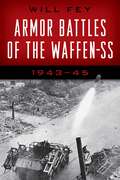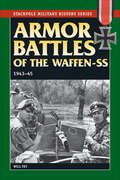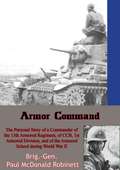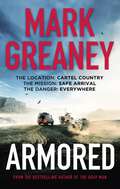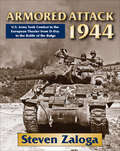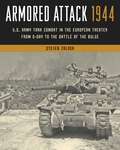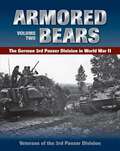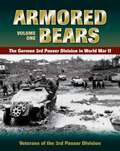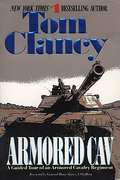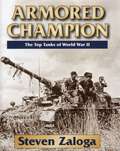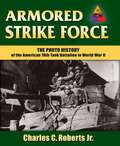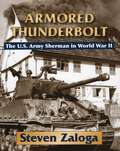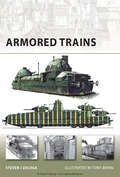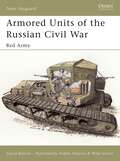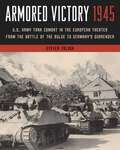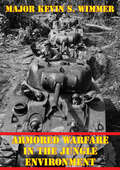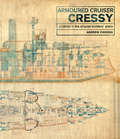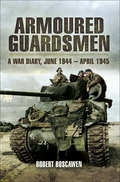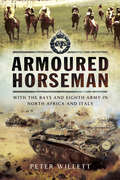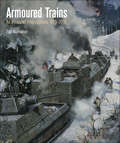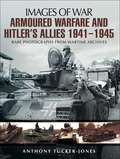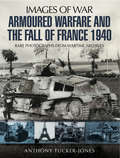- Table View
- List View
Armor Battles of the Waffen-SS: 1943–45
by Will FeyThe Waffen-SS were considered the elite of the German armed forces in the Second World War and were involved in almost continuous combat. From the sweeping tank battle of Kursk on the Russian front to the bitter fighting among the hedgerows of Normandy and the last great offensive in the Ardennes, forever immortalized in history as the Battle of the Bulge, these men and their tanks made history.
Armor Battles of the Waffen-SS: 1943–45 (Stackpole Military History Series)
by Will FeyThis German WWII military history offers an in-depth view of armored combat across Europe from the perspective of the Waffen SS. The Waffen SS were considered the elite of the German armed forces in the Second World War and were involved in almost continuous combat. In this volume, a former Waffen SS captain offers an in-depth account of their armored combat operations across the European Theater and into the Eastern Front. From the sweeping tank battle of Kursk in southwestern Russian to the bitter fighting among the hedgerows of Normandy and the last great offensive in the Ardennes, forever immortalized in history at the Battle of the Bulge, this chronicle presents a vivid frontline view of the drama.
Armor Command: of CCB, 1st Armored Division, and of the Armored School during World War II
by Brig.-Gen. Paul McDonald Robinett“Armor Command is a candid book presenting the activities and observations of an armor commander who was among the first overseas and in action against the European Axis in World War II. All who are interested in the activities of combat troops that make or break the reputations of high military figures and all those who desire an understanding of life in the combat zone will find this book of compelling interest. Military men will find it of professional value for it deals with the problems of a small command in the initial campaign against the German-Italian Allies. Among other things it deals with the problems of the meeting engagement and the withdrawal—two of the most difficult operations in war.”—Foreword
Armor In Vietnam [Illustrated Edition]
by Frederick Eugene OldinskyIncludes 24 mapsThis thesis begins with a brief history of armored vehicles from their earliest concepts to the modern battle tank of today. It critically examines the decision not to include tank units with the first American combat forces deployed in Vietnam and the irrationality of that decision in light of a similar decision made prior to the Korean conflict.Tanks were deployed in limited numbers in Vietnam in spite of a decision to the contrary and, once there, I proved their usefulness and their ability to perform in a tropical environment against an elusive enemy. Examples of the tank's effectiveness in Vietnam are given and the feasibility of deploying major armored forces to that country is discussed.Problems created by insufficient armor are addressed as well as the limitations and vulnerabilities of tanks and other armored vehicles.Armor doctrine is traced from the tank's role in breaking the stalemate of World War I through the formative years of World War II, and its application to the war in Vietnam.Since most armored weapons were designed primarily for conventional warfare, a number of modifications were required to adapt the weapons to an unconventional war. Some of the more significant modifications are described.Finally, lessons learned by the Vietnam experience and their future application are discussed. Concluding consideration in the paper is whether or not decision makers will need these lessons learned or continue to make the same mistakes.
Armor and Blood: The Battle of Kursk
by Dennis E. ShowalterOne of America's most distinguished military historians offers the definitive account of the greatest tank battle of World War II--an epic clash of machines and men that matched the indomitable will of the Soviet Red Army against the awesome might of the Nazi Wehrmacht. While the Battle of Kursk has long captivated World War II aficionados, it has been unjustly overlooked by historians. Drawing on the masses of new information made available by the opening of the Russian military archives, Dennis Showalter at last corrects that error. This battle was the critical turning point on World War II's Eastern Front. In the aftermath of the Red Army's brutal repulse of the Germans at Stalingrad, the stakes could not have been higher. More than three million men and eight thousand tanks met in the heart of the Soviet Union, some four hundred miles south of Moscow, in an encounter that both sides knew would reshape the war. The adversaries were at the peak of their respective powers. On both sides, the generals and the dictators they served were in agreement on where, why, and how to fight. The result was a furious death grapple between two of history's most formidable fighting forces--a battle that might possibly have been the greatest of all time. In Armor and Blood, Showalter re-creates every aspect of this dramatic struggle. He offers expert perspective on strategy and tactics at the highest levels, from the halls of power in Moscow and Berlin to the battlefield command posts on both sides. But it is the author's exploration of the human dimension of armored combat that truly distinguishes this book. In the classic tradition of John Keegan's The Face of Battle, Showalter's narrative crackles with insight into the unique dynamics of tank warfare--its effect on men's minds as well as their bodies. Scrupulously researched, exhaustively documented, and vividly illustrated, this book is a chilling testament to man's ability to build and to destroy. When the dust settled, the field at Kursk was nothing more than a wasteland of steel carcasses, dead soldiers, and smoking debris. The Soviet victory ended German hopes of restoring their position on the Eastern Front, and put the Red Army on the road to Berlin. Armor and Blood presents readers with what will likely be the authoritative study of Kursk for decades to come.Advance praise for Armor and Blood "The size and the brutality of the vast tank battle at Kursk appalls, this struggle that gives an especially dark meaning to that shopworn phrase 'last full measure.' Prepare yourself for a wild and feverish ride over the steppes of Russia. You can have no better guide than Dennis E. Showalter, who speaks with an authority equaled by few military historians."--Robert Cowley, founding editor of MHQ: The Quarterly Journal of Military History "A fresh, skillful, and complete synthesis of recent revelations about this famous battle . . . As a myth buster, Armor and Blood is a must-read for those interested in general and military history."--David M. Glantz, editor of The Journal of Slavic Military Studies"Refreshingly crisp, pointed prose . . . Throughout, [Showalter] demonstrates his adeptness at interweaving discussions of big-picture strategy with interesting revelations and anecdotes. . . . Showalter does his best work by keeping his sights set firmly on the battle at hand, while also parsing the conflict for developments that would have far-reaching consequences for the war."--Publishers Weekly
Armored (Armored)
by Mark GreaneyOne last job, out of the fire, and into hell...From the #1 New York Times bestselling author of The Gray Man series comes a very different kind of hero.Joshua Duffy is a Close Protection Agent - a professional bodyguard, and he's one of the world's elite operatives. That is he was until his last mission in Lebanon. Against all odds, Josh got his primary out alive, but the cost was high. Josh lost his lower left leg. There's not much call for an elite bodyguard with such an injury. So, Josh has to support his family working as a mall cop in Jersey. For a man like Josh this is purgatory on earth, but even in Paramus miracles occur. A lucky run in with an old comrade promises to get Josh back in the field for one last job. The UN is sending a peace mission into the Sierra Madre Mountains in Mexico, an area so dangerous it's known as Espinazo del Diablo (The Devil's Spine). Only a fool would think they could broker peace between the homicidal drug cartels in the region and only a madman would sign on to keep those fools alive.Soon to be a major film by Michael Bay, Armored is a gasp-a-minute rollercoaster of a thriller.
Armored Attack 1944: U.S. Army Tank Combat in the European Theater from D-Day to the Battle of the Bulge
by Steven ZalogaAlmost 1,200 photos of American World War II armor from Shermans to Hellcats, accompanied by informative captions by a prominent military historian. Covering D-Day, the Normandy campaign, southern France, the Siegfried Line, the push to the Rhine, and the Battle of the Bulge, this pictorial history—the first of a two-volume set—includes 1,199 photographs of all varieties of American armor. Filled with images of U.S. Army armored units in combat in the European theater of operations, it&’s a rich resource for tank enthusiasts, modelers, and those interested in the military history of World War II.
Armored Attack 1944: U.S. Army Tank Combat in the European Theater from D-Day to the Battle of the Bulge
by Steven ZalogaThis classic, now available in paperback, includes all varieties of American armor in Europe from D-Day, to Normandy, to southern France, the Siegfried Line, the push to the Rhine, and finally, the Battle of the Bulge. Shermans, Hellcats, and many more American and German tanks are covered in nearly 1200 photos along with Steven Zaloga&’s expert captions. Perfect for modelers and World War II enthusiasts.
Armored Bears
by Veterans of the 3rd Panzer DivisionFirst major treatment of the 3rd Panzer Division in English.
Armored Bears
by Veterans of the 3rd Panzer DivisionFirst major treatment of the 3rd Panzer Division in English.
Armored Cav: A Guided Tour Of An Armored Cavalry Regiment (Tom Clancy's Military Referenc #2)
by Tom ClancyA penetrating look inside an armored cavalry regiment -- the technology, the strategies, and the people . . . profiled by Tom Clancy.His first non-fiction book, Submarine, captured the reality of life aboard a nuclear warship. Now, the #1 bestselling author of Clear and Present Danger and Without Remorse portrays today's military as only army personnel can know it. With the same compelling, you-are-there immediacy of his acclaimed fiction, Tom Clancy provides detailed descriptions of tanks, helicopters, artillery, and more -- the brilliant technology behind the U. S. Army. He captures military life -- from the drama of combat to the daily routine -- with total accuracy, and reveals the roles and missions that have in recent years distinguished our fighting forces. Armored Cav includes:Descriptions of the M1A2 Main Battle Tank, the AH-64A Apache Attack Helicopter, and moreAn interview with General Frederick FranksStrategies behind the Desert Storm accountExclusive photograph, illustrations and diagramsPLUS: From West Point cadet to Desert Storm commander . . . an interview with a combat cavalry officer on the rise.
Armored Champion
by Steven ZalogaArmor expert Zaloga enters the battle over the best tanks of World War II with this heavy-caliber blast of a book armed with more than forty years of research.
Armored Strike Force: The Photo History of the American 70th Tank Battalion in World War II
by Charles C. RobertsThe U.S. 70th Tank Battalion boasts one of the most impressive combat records of any American armored unit in World War II. It landed in North Africa as part of Operation Torch and participated in the invasion of Sicily, D-Day, the Normandy campaign, the Battle of the Bulge, and the final drive into Germany. It remains in service today as the 70th Armor Regiment, the U.S. Army's most decorated armor unit.
Armored Thunderbolt
by Steven ZalogaHundreds of photos, including many never published before with riveting accounts of armored warfare in World War II. Compares the Sherman to other tanks, including the Panther and Tiger. Author is a world-renowned expert on the Sherman tank and American armor.
Armored Trains
by Steven J. Zaloga Tony BryanFirst seen during the American Civil War and later appearing in the Franco-Prussian War and the Anglo-Boer Wars, the armored train came to prominence on the Eastern Front during World War I. It was also deployed during the Russian Civil War and the technology traveled east into the Chinese Civil War, and the subsequent war with Japan. It saw service on the Russian Front in World War II, but was increasingly sidelined by its vulnerability to air attack. Steven J Zaloga examines the origins and development of the armored train focusing equally on the technical detail and on the fascinating story of how armored trains were actually used in combat. This title will appeal to armor, military history and railroad enthusiasts alike.From the Trade Paperback edition.
Armored Units of the Russian Civil War
by Peter Sarson David BullockBy 1920 the Red Army fielded an overwhelming array of armored cars and armored trains, while tank detachments had begun forming in earnest. These armored units played an important part in consolidating the newly won Bolshevik empire in the early 1920s; as a consequence of the fact that railways were the strategic arteries that essentially controlled Russia, armored trains have never played such a significant role in military history as they did in the Russian Civil War. This title details their management, construction and repair, personnel and training and combat on all fronts, as well as discussing Trotsky's armored train, in which he conducted 36 tours.
Armored Victory 1945: U.S. Army Tank Combat in the European Theater from the Battle of the Bulge to Germany's Surrender
by Steven ZalogaThe second in Steven Zaloga&’s classic two-volume photo history of American armor in Europe is now available in paperback. Covering the Battle of the Bulge, the Rhine crossings, and the final battles inside Germany, the book is beautifully illustrated with more than 1200 photos of American tanks and armored vehicles as well as many German tanks.
Armored Warfare In The Jungle Environment
by Major Kevin S. WimmerThis study examines armored warfare in a jungle environment. The focus is to determine if there is a role for ground mounted armored forces in jungle warfare. This study explains how armor was used in past jungle conflicts and examines current doctrine and applicability of employment of armor in the jungle.The first portion of the research focuses on discerning how armor was used in past jungle conflicts. The Pacific campaign of World War II and the Vietnam War are examined to determine the historical role of armor in a jungle environment. Early employment of armor in these two conflicts is examined to determine the criteria for use of armored forces in the jungle and examines the tactics, techniques, and procedures that were developed during these conflicts.The second portion of this study focuses on the feasibility of current employment of armor in a jungle environment. Current Army and Marine armored doctrine is examined and interviews are conducted to determine if current armored systems could and should be employed in jungle warfare. Additionally, officers from foreign countries are interviewed to determine how armored forces are employed in the jungle areas of their countries.
Armour and Masculinity in the Italian Renaissance
by Carolyn SpringerDuring the Italian Wars of 1494 to 1559, with innovations in military technology and tactics, armour began to disappear from the battlefield. Yet as field armour was retired, parade and ceremonial armour grew increasingly flamboyant. Displaced from its utilitarian function of defense but retained for symbolic uses, armour evolved in a new direction as a medium of artistic expression. Luxury armour became a chief accessory in the performance of elite male identity, coded with messages regarding the owner's social status, genealogy, and political alliances. Carolyn Springer decodes Renaissance armour as three-dimensional portraits through the case studies of three patrons of luxury armourers, Guidobaldo II della Rovere (1514-75), Charles V Habsburg (1500-58 and Holy Roman Emperor from 1519-56), and Cosimo I de'Medici (1519-74). A fascinating exposition of male self-representation, Armour and Masculinity in the Italian Renaissance explores the significance of armour in early modern Italy as both cultural artefact and symbolic form.
Armoured Cruiser Cressy: Detailed in the Original Builders' Plans
by Andrew ChoongThe complete set of builders’ plans for the Royal Navy’s Victorian era armored cruiser famously sunk during WWI.The builders of British warships created a highly detailed set of plans for each ship upon completion. These highly detailed, multicolored drawings represented the exact appearance and specifications of the ship as it entered service. Today, the National Maritime Museum and Seaforth Publishing are making these invaluable resources available to the public through a series of books featuring high-quality digital reproductions.This volume presents the plans for the armored cruiser HMS Cressy. Launched on December 4th, 1899, it best known for the disaster of September 22nd, 1914, in which Cressy and two sister-ships were sunk by a small submarine. Though obsolete by the First World War, Cressy-class cruisers were innovative ships in their day.In full color, with many close-ups and enlargements, these plans make every aspect of the HMS Cressy clear and comprehensible. Extensive captions point the reader to important features to be found in the plans, and an introduction covers the design’s background.
Armoured Guardsman: A War Diary, June 1944–April 1945
by Robert Boscowan&“A rare treat: a well-written account of what it was like to serve as a junior rank in the Brigade of Guards during the Second World War.&” —The Guards Magazine The outbreak of World War II brought many changes to Britain&’s Brigade of Guards. The dress-parade units had always maintained a full combat capacity and made a relatively easy transition into a new unit, the Guards Armoured Division. The Guards landed in Normandy on 26 June 1944 and steadily fought their way across northern Europe. Robert Boscawen was a tank commander in the 1st Coldstream Guards and had four tanks shot from under him. On the fourth occasion he was badly wounded and burned, making a difficult postwar recovery. The years after the war, however, also brought both business and political success, culminating in a twenty-three-year career in Parliament. Boscawen&’s account of Britain&’s elite at war is based on his wartime diaries. &“Tells the author&’s story in a most readable yet matter-of-fact way. It is one of the finest accounts of armoured warfare that I have ever read and I have no hesitation in recommending it to anyone who has not.&” —Tank Regiment Magazine
Armoured Horseman: With the Bays and Eight Army in North Africa and Italy
by Peter WillettA veteran with the Queen&’s Bays in the British Army recounts service during World War II and his career in horse racing post-war. New memoirs by combatants in the Second World War are sadly rare today due to the passage of time. Armoured Horsemen will be warmly welcomed as the author, now into his 90s, fought through with The Bays from Alamein to Tunis and then on up Italy until VE Day. As a young tank troop commander his chances of survival were slim and tragically many of his friends were killed. Peter Willett, a professional journalist and prolific author, is superbly qualified to describe his war and the experiences of his fellow cavalrymen. He tells a moving story with characteristic lightness of touch and modesty. As well as satisfying the military enthusiast, Armoured Horseman will find a ready audience in the racing fraternity. Peter describes equestrian activities in post-war Austria and goes on to summarise his career as a racing journalist, authority on breeding, membership of the Jockey Club and long association with Goodwood.Praise for Armoured Horseman &“Overall this is a rather entertaining description of life in a unit at the heart of some of the most significant events of the Desert War.&” —History of War &“This new book covers familiar ground, because there have been many books that tell the story of the major North African and Italian campaigns, but it brings forward a unique story that is fascinating, compelling and charming. This is a must read WWII account but it will also appeal for its horse racing connections and the very human story that it tells.&” —Firetrench &“What a truly wonderful book! I almost felt I was there and realised that between all the horrors of war there were also some better times and great friendships recounted so brilliantly. It should be made into a film!&” —Nicola Howard-Jones
Armoured Trains: An Illustrated Encyclopedia, 1825–2016
by Paul MalmassariThe military was quick to see the advantages of railways in warfare, whether for the rapid deployment of men or the movement of heavy equipment like artillery. From here it was a short step to making the train a potent weapon in its own right a mobile fort or a battleship on rails. Armed and armored, they became the first practical self-propelled war machines, which by the time of the American Civil War were able to make a significant contribution to battlefield success. Thereafter, almost every belligerent nation with a railway system made some use of armored rolling stock, ranging from low-intensity colonial policing to the massive employment of armored trains during the Russian Civil War. And although they were somewhat eclipsed as frontline weapons by the development of the tank and other AFVs, armoured trains retained a role as late as the civil wars in the former republic of Yugoslavia.This truly encyclopedic book covers, country by country, the huge range of fighting equipment that rode the rails over nearly two centuries. While it outlines the place of armored trains in the evolution of warfare, it concentrates on details of their design through a vast array of photographs and the authors meticulous drawings. Published in French in 1989, this highly regarded work has been completely revised and expanded for this English edition. It remains the last word on the subject.
Armoured Warfare and Hitler's Allies, 1941–1945: Rare Photographs from Wartime Archives (Images of War)
by Anthony Tucker-JonesThis WWII pictorial history sheds light on the armored fighting vehicles built and deployed by Italy, Hungary and other Axis powers on the Eastern Front. In discussions of Second World War military vehicles, German, American and British tanks are given the most focus. Meanwhile, the tanks, self-propelled guns and armored cars built and deployed by Hitler&’s Axis allies, have been almost forgotten. Both the rarity of these fighting vehicles and the vital roles they played in battle make them a fascinating subject of photographic history. This selection of previously unpublished wartime photographs provides a visual record of the armored forces thrown into action by Hitler&’s allies on the Eastern Front from 1941 to 1945. Illustrated here are the panzers deployed by Bulgaria, Finland, Slovakia, Hungary, Italy and Romania on the Eastern Front and in the Balkans. Hungary&’s home-made armor included the Toldi and Turán tanks and Zrínyi self-propelled guns. The Italians produced CV-33 tankettes, Semovente self-propelled guns, Autoblinda and Lancia armored cars and a series of tanks. Romanian and Czech tanks and assault guns were also deployed.
Armoured Warfare and the Fall of France 1940: Rare Photographs From Wartime Archives (Images of War)
by Anthony Tucker-JonesAt 21:00 on 9 May 1940 Codeword Danzig was issued alerting Adolf Hitler's airborne troops that they were about to spearhead an attack on Belgium and the Netherlands. The following day his blitzkrieg rolled forward striking the British Expeditionary Force and the French armies in Belgium and in northern France at Sedan. The desperate attempts of the allied armies to stem the Nazi tide proved futile and, once their reserves had been exhausted and the remaining forces cut off, Paris lay open. By early June, it was all over - trapped British, Belgian and French troops were forced to evacuate Dunkirk, Calais and Boulogne and the defeated French army agreed to an armistice leaving the country divided in two. This dramatic story is shown in a sequence of over 150 historic photographs that Anthony Tucker-Jones he has selected for this memorable book. The images he has chosen cover every aspect of this extraordinary campaign, but his main focus is on the vital role played by the armoured fighting vehicles of both sides. The book is a graphic record of the destruction wrought by the Wehrmacht's lightning offensive through the Low Countries and France.
